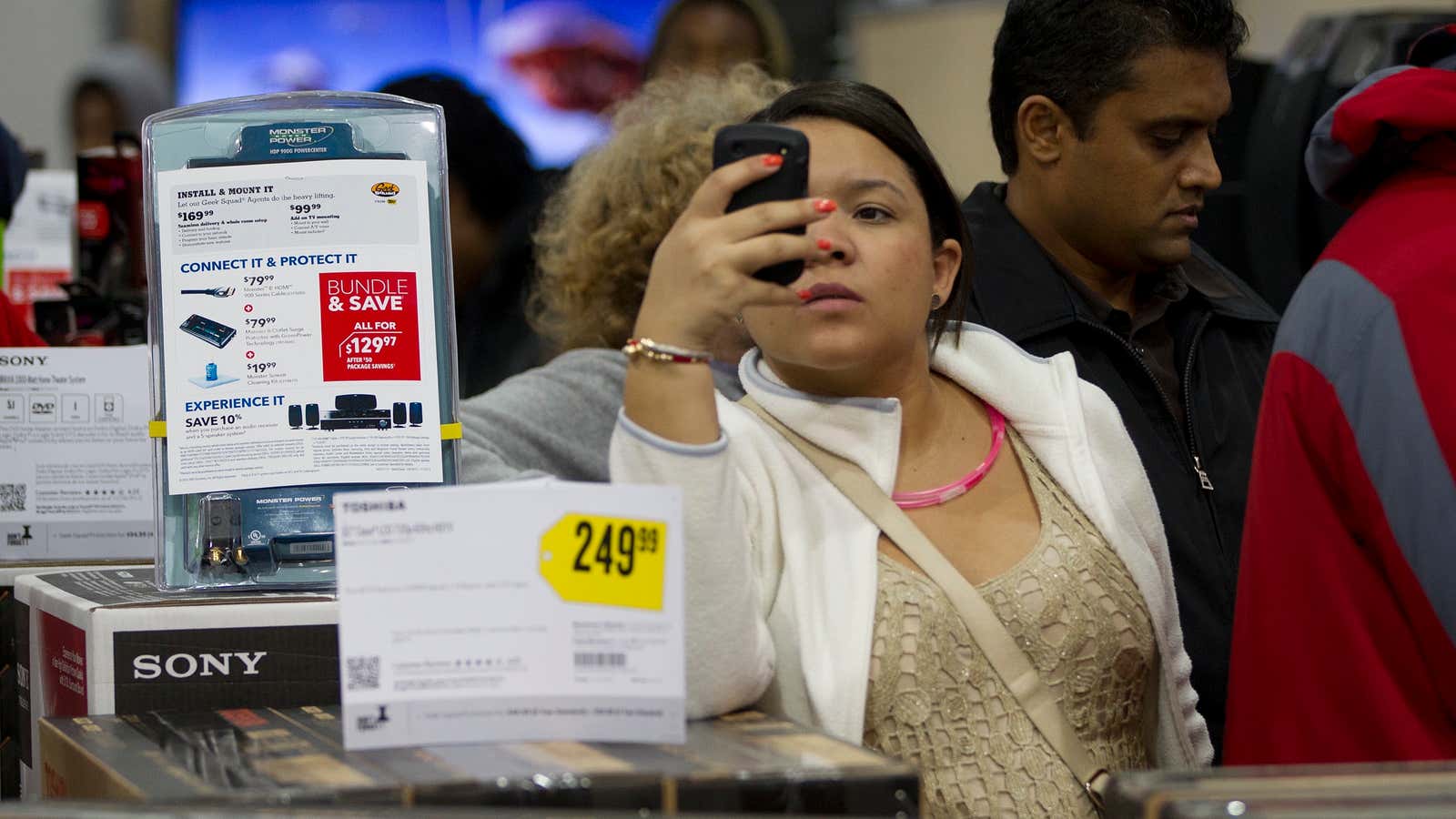The economics of e-commerce suggests that many kinds of stores may soon be as scarce as independent booksellers, and for the same reasons. Shoppers go into a store, try out the goods, wear out the floor samples, pepper employees with questions, and then either go home or whip out their phones and, then and there, buy the same product from a different retailer online, more cheaply.
It’s a behavior called “showrooming“, and right now more than half of US holiday shoppers are engaging in it. This trend is killing big box retailers like Best Buy, which is fighting back by matching online prices on items available in its stores, at least during the holiday season. As showrooming becomes the norm, Best Buy is now, in effect, an unpaid sales affiliate of Amazon.com and countless other online retailers. Not coincidentally, Amazon.com was the top online retailer on Black Friday, the biggest shopping day of the year in the US.
Boffins in “retail experience divisions” of large retailers have already taken this trend to its logical conclusion. In 2011, The Homeplus discount retail chain in Korea (jointly owned by Tesco and Samsung) created a “virtual store” in an underground rail station in Seoul.
Shoppers with smartphones load up the Homeplus app, then snap pictures of the square barcodes (called QR codes) that appear below items they’d like to buy. Later, the items are delivered to wherever they want. Subsequent further experiments in virtual stores in Asia suggest this is more than just a fad; we might all shop this way some day, especially in dense cities where long commutes make virtual stores that much more appealing.
Virtual stores and showrooming might not seem to have that much in common, until you realize that a showroom is just a virtual store where the objects aren’t virtual. Or conversely, a virtual store is a physical showroom where the merchandise has been reduced to two-dimensional advertisements or billboards. Either way, a virtual store eliminates most of the costs associated with running a conventional store, while offering some of the psychological immediacy of shopping in one.
It would be absurd to argue that physical retail is going to go away altogether. Apple stores are a sort of showroom, as well as a testament to the power of in-person customer service. But Apple, as the exclusive distributor of Apple products, doesn’t have to worry about being undercut by online competitors.
Retailers are well aware of these trends. Wal-Mart’s total 2011 revenue is ten times that of Amazon, yet Amazon has ten times as much online revenue as Wal-Mart. That’s why in order to compete, Wal-Mart went on a Silicon Valley hiring binge and now has a crack team of experienced e-commerce innovators doing everything from using buzz on social media to determine which goods to stock to revamping Walmart.com’s previously embarrassing search function. CEO Mike Duke said the company is “playing to win” in e-commerce.
In whatever’s left of retail once ecommerce has finished eliminating or transforming some of its biggest players, the fusion between mobile and in-store shopping will take many forms. Retailers like Macy’s department store in the US and grocery giant Tesco in the UK are already providing shoppers with maps that help them find goods in stores. Using the latest position-detecting chips in smartphones or even just plain old wifi signals, retailers will soon be able to know exactly where shoppers are, to within inches.
Ubiquitous smartphones could also mean the end of traditional checkouts. Some retail experiments already allow shoppers to scan and pay for goods themselves with their phones, as they place them in their shopping bags. Tablet-based point-of-sale terminals like Square‘s will allow roaming salespeople to complete transactions without cash registers (much as Apple Store employees now take your payment on the spot using a modified iPhone), and people will be able to pay using mobile wallets on their smartphones via wifi, near field communication, barcodes or a handful of other technologies.
The sheer variety of opportunities for buying things means the future of retail will be a hybrid between showrooms, virtual stores and traditional stores tricked out with a variety of novel ways to pay. The question is, which retailers will do best in each of these modes, or some combination of them. It’s not hard to imagine that, having saturated the online market, some online retailers will eventually have to create physical showrooms of their own. Shrunken, more-specialized, more boutique-like successors to Best Buy, carrying mostly products not available from other retailers, could be juxtaposed in the world’s strip malls and urban shopping arcades with showrooms that carry no inventory beyond display models.
Further ahead, there are even wilder possibilities. Augmented reality, enabled by computerized spectacles like Google Glass and its inevitable competitors, could turn any available surface or empty retail space into a virtual store: Just look at a wall, load up the relevant shopping app, and the wall becomes a shelf of virtual goods. And if you believe the Maker movement, we’ll all be 3D-printing goods at home, and never need to leave the house again except to drop off our genetic material at the local baby factory.
As for conventional retailers, bargain-hunting will continue to slash their margins—except when they’re being padded by whatever kinds of convenience and experience it turns out shoppers are willing to pay for. These could include, for example personal shopping concierges. Whatever else happens, we’re looking at a future in which physical and online retailers have to compete with each other on much more than just price, and the distinction between them becomes a lot more blurry.
